We produce only Natural Wines, using only local grapes. We grow 13 different estate varietals, mostly the Italian ones, and we source other 8 from local growers with whom we built a trustful and strong relationship over the years.
We believe in each grape natural taste and evolution, which makes different wines year after year, all 100% that specific grape, all narrations of that specific coincidence of weather, terroir, winemaker, chance.

Given the broad expanse of the Malvasia family, generalizations about the Malvasia wine are difficult to pin point. Most varieties of Malvasia are derived from Malvasia bianca which is characterized by its deep color, noted aromas and the presence of some residual sugar.

Is a white Italian wine grape variety that is grown primarily in the Campania region of southern Italy and on the island of Sicily. In Campania, this fairly strong flavored white wine grape is particularly noted around Avellino where the Denominazione di origine controllata e Garantita (DOCG) wine of Fiano di Avellino is produced. The grape has a long history in the Campanian region and is believed to have been the grape behind the ancient Roman wine Apianum. Even today, the name Apianum is permitted to appear on wine labels of the DOCG wine Fiano di Avellino. Beyond its strong flavors and intense aroma notes which can include hazelnut, pear, orange peel, or pine, the Fiano grapevine is noted viticulturally for the relatively low yields it produces.
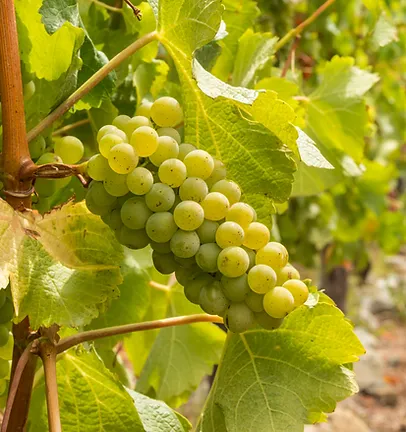
Sauvignon blanc is a green-skinned grape variety that originates from the Bordeaux region of France. The grape most likely gets its name from the French words sauvage (“wild”) and blanc (“white”) due to its early origins as an indigenous grape in South West France.[1] It is possibly a descendant of Savagnin. Depending on the climate, the flavor can range from aggressively grassy to sweetly tropical. In cooler climates, the grape has a tendency to produce wines with noticeable acidity and “green flavors” of grass, green bell peppers and nettles with some tropical fruit (such as passion fruit) and floral (such as elderflower) notes. In warmer climates, it can develop more tropical fruit notes but risks losing much aroma from over-ripeness, leaving only slight grapefruit and tree fruit (such as peach) notes.

Is s a green-skinned grape variety used in the production of white wine. The variety originated in the Burgundy wine region of eastern France, but is now grown wherever wine is produced, from England to New Zealand. For new and developing wine regions, growing Chardonnay is seen as a ‘rite of passage’ and an easy entry into the international wine market. The Chardonnay grape itself is neutral, with many of the flavors commonly associated with the wine being derived from such influences as terroir and oak.It is vinified in many different styles, from the lean, crisply mineral wines of Chablis, France, to New World wines with oak and tropical fruit flavors. In cool climates (such as Chablis and the Carneros AVA of California), Chardonnay wine tends to be medium to light body with noticeable acidity and flavors of green plum, apple, and pear. In warmer locations (such as the Adelaide Hills and Mornington Peninsula in Australia and Gisborne and Marlborough region of New Zealand), the flavors become more citrus, peach, and melon, while in very warm locations (such as the Central Coast AVA of California), more fig and tropical fruit notes such as banana and mango come out. Wines that have gone through malolactic fermentation tend to have softer acidity and fruit flavors with buttery mouthfeel and hazelnut notes. Chardonnay is an important component of many sparkling wines around the world, including Champagne and Franciacorta in Italy.
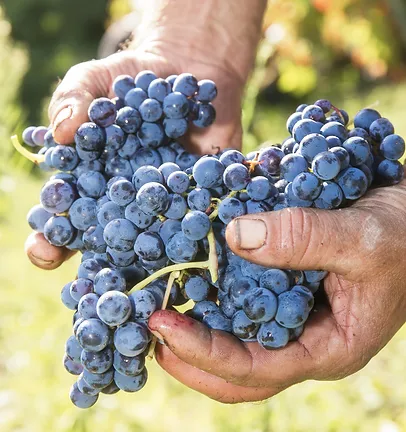
Is a black grape grown in the southern regions of Italy, mostly Basilicata and Campania. It is considered with Sangiovese and Nebbiolo to be one of the three greatest Italian varieties. Aglianico is sometimes called “The Barolo of the South” (il Barolo del Sud) due to its ability to produce highly refined, complex fine wines like the famous Piedmont wine, Barolo
The origins of both the vine itself and its name are unclear. Traditionally, the vine is thought to have originated in Greece, first cultivated by Phocians from an unidentified ancestral vine; it was then brought to Cumae, near modern-day Pozzuoli, by Greek settlers in the 8th century BC, and from there it spread into southern Italy. The name may be a corruption of vitis hellenica (Latin for ‘”Greek vine”‘), or of Apulianicum, the Latin name for the whole of southern Italy in the time of ancient Rome. Wines produced from Aglianico tend to be full-bodied with firm tannins and high acidity, endowing them with good aging potential. The rich flavors of the wine make it appropriate for pairing with rich meats such as lamb. In Campania, the grape is sometimes blended with Cabernet Sauvignon and Merlot in the production of some Indicazione Geografica Tipica (IGT) wines. In its youth, Aglianico is very tannic and concentrated, requiring a few years of ageing before it can be approachable. As it ages, the fruit becomes more pronounced and the tannins more balanced with the rest of the wine. The trademark coloring of the wine is a deep garnet. In well made examples of the wine, it can have chocolate and plum aromas.
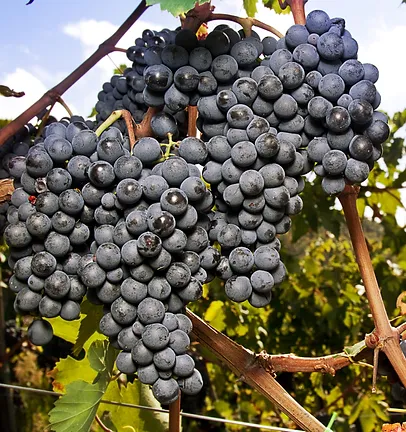
Is a red Italian wine grape variety that derives its name from the Latin sanguis Jovis, “the blood of Jupiter”. Though it is the grape of most of central Italy from Romagna down to Lazio (the most widespread grape in Tuscany), Campania and Sicily, outside Italy it is most famous as the only component of Brunello di Montalcino and Rosso di Montalcino and the main component of the blends Chianti, Carmignano, Vino Nobile di Montepulciano and Morellino di Scansano, although it can also be used to make varietal wines such as Sangiovese di Romagna and the modern “Super Tuscan” wines like Tignanello. Young Sangiovese has fresh fruity flavours of strawberry and a little spiciness, but it readily takes on oaky, even tarry, flavours when aged in barrels. While not as aromatic as other red wine varieties such as Pinot noir, Cabernet Sauvignon, and Syrah, Sangiovese often has a flavour profile of sour red cherries with earthy aromas and tea leaf notes. Wines made from Sangiovese usually have medium-plus tannins and high acidity.Surely the most famous grape in Italy. Its structure is more acidic than tannic, and its flavor is salty, spicy, earthy, and hint of balsamic.

Native to Tuscany and is most popularly known on the Island of Elba. It is related to
white grapes and is sweet with floral aromas. It has the flavors of spice and red fruits such as
cherries.
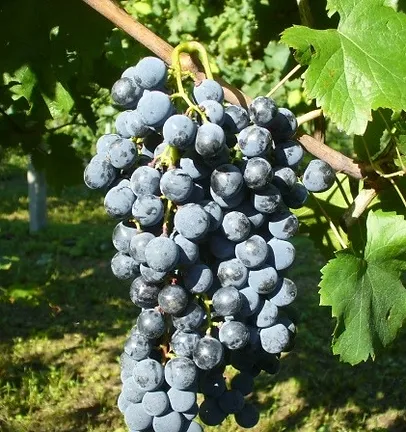
Planted primarily in the Campania region. The grape is considered a specialty of the region, being used to produce wines for local and tourist consumption. Its name “piedirosso” means “red feet” that reflects the bottom of the vine which used to be red similar to the red feet of a pigeon.

“The most important red wine grape in Sicily” and is one of Italy’s most important indigenous varieties. It is named after Avola in the far south of Sicily, and its wines are compared to New World Shirazes, with sweet tannins and plum or peppery flavours. It also contributes to Marsala Rubino blends

The earliest knowledge of this varietal is that it originated in Greece. It is not known exactly how or when this plant was transported into Italy, but the history of this grape in Italy dates back many centuries. In the 17th century, it is known that the Benedictine monks named the varietal “Primitivo” because of its precociousness (early maturity of the grape) in this zone. Primitivo is widely spread throughout the north/eastern coast of central Italy

Most notably a wine found in Barolo region of the Piedmont area of Italy. It looks like
a light-bodied wine but is an intense, structured, and tannic wine. It is believed that the name stems from the word Nebbia (fog), because of the thick, white blooms of yeast that can form on the grapes when they are ripe.

Wine has been produced since ancient times in “Campo Rotaliano”, an alluvial plain between the rivers Adige (Etsch) and Noce. Teroldego may take its name from its traditional method of cultivation, trained on a system of “tirelle” or wire harnesses, an explanation that’s more likely, albeit less pretty, than its legendary association with German dialect for gold of the Tirol. Another theory, put forth in the book “Wine Grapes” credits a northern Italian village called Teroldege, or Teroldeghe, where documents dated in 15th century refer to the sale of Teroldego wine. It has recently been discovered to be a full sibling of the Dureza variety from France, which is one of the parents of Syrah.
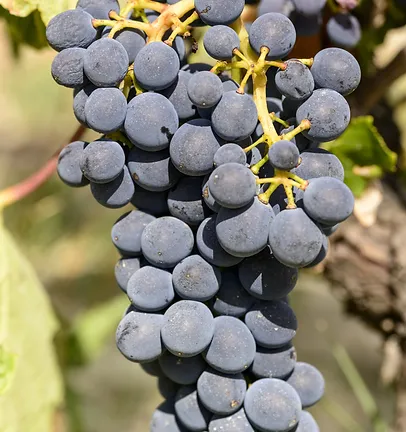
Is a black Italian wine grape variety widely grown in the Piedmont region of northwest Italy. The Italian word dolcetto means “little sweet one”, but it is not certain that the name originally carried any reference to the grape’s sugar levels: it is possible that it derives from the name of the hills where the vine is cultivated. In any case the wines produced are nearly always dry. They can be tannic and fruity with moderate, or decidedly low, levels of acidity and are typically meant to be consumed within a few years after release.
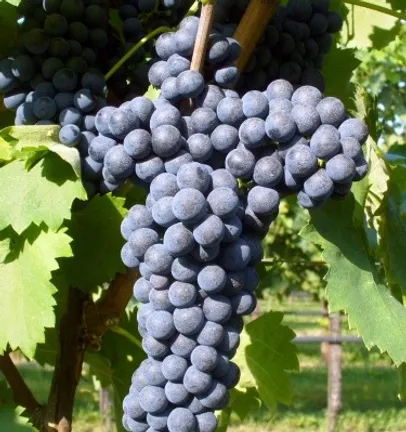
Sagrantino is a vigorous, relatively disease-resistant yet low-yielding vine. Although it flowers early, and reaches veraison early to form thick dark skins and large pips, it requires a long hot season to ripen, producing small slightly conical winged bunches, late in the season; in Umbria usually late October. The grape has one of the highest tannic levels of any variety in the world. Its wines contain more tannin than those made from Aglianico or Tannat, and twice the level of Cabernet Sauvignon or Nebbiolo wines. It creates wines that are inky purple with an almost-black center. The bouquet is one of dark, brooding red fruits with hints of plum, cinnamon, and earth.

In the 1860s the French botanist François Durif kept a nursery of several grape varieties at his home in the commune of Tullins where he most likely had plantings of both Peloursin and Syrah. At some point the two vines cross pollinated and Durif discovered a new grape variety growing in his nursery. It was identified and named Plant du Rif (later Durif) by ampelographer Victor Pulliat in 1868. As a conclusion of DNA fingerprinting at the University of California, Davis in 1997, Syrah was identified as the source of the pollen that originally crossed with Peloursin flowers. The grape’s high resistance to downy mildew encouraged its cultivation in the early 20th century in areas like Isère and Ardèche, although the relative low quality of the resulting wine caused the grape to fall out of favor with local wine authorities. Today, it is almost nonexistent in France.

Merlot is a dark blue–colored wine grape variety, that is used as both a blending grape and for varietal wines. The name Merlot is thought to be a diminutive of merle, the French name for the blackbird, probably a reference to the color of the grape. Its softness and “fleshiness”, combined with its earlier ripening, makes Merlot a popular grape for blending with the sterner, later-ripening Cabernet Sauvignon, which tends to be higher in tannin. Along with Cabernet Sauvignon, Cabernet Franc, Malbec and Petit Verdot, Merlot is one of the primary grapes used in Bordeaux wine, and it is the most widely planted grape in the Bordeaux wine regions. Merlot is also one of the most popular red wine varietals in many markets. This flexibility has helped to make it one of the world’s most planted grape varieties.

Also known as Shiraz, is a dark-skinned grape variety grown throughout the world and used primarily to produce red wine. In 1999, Syrah was found to be the offspring of two obscure grapes from southeastern France, Dureza and Mondeuse Blanche. Syrah should not be confused with Petite Sirah, a cross of Syrah with Peloursin dating from 1880.
The style and flavor profile of wines made from Syrah are influenced by the climate where the grapes are grown with moderate climates (such as the northern Rhone Valley and parts of the Walla Walla AVA in Washington State) tending to produce medium to full-bodied wines with medium-plus to high levels of tannins and notes of blackberry, mint and black pepper. In hot climates (such as Crete, and the Barossa Valley and McLaren Vale regions of Australia), Syrah is more consistently full-bodied with softer tannin, jammier fruit and spice notes of licorice, anise and earthy leather. In many regions the acidity and tannin levels of Syrah allow the wines produced to have favorable aging potential.

Is a purple grape variety used in making red wine. The grapes tend to have an inky dark color and robust tannins, and are known as one of the six grapes allowed in the blend of red Bordeaux wine. In France, plantations of Malbec are now found primarily in Cahors in South West France, though the grape is grown worldwide. It is increasingly celebrated as an Argentine varietal.
The grape became less popular in Bordeaux after 1956 when frost killed off 75% of the crop. Despite Cahors being hit by the same frost, which devastated the vineyards, Malbec was replanted and continued to be popular in that area. Winemakers in the region frequently mixed Malbec with Merlot and Tannat to make dark, full-bodied wines, but have ventured into 100% Malbec varietal wines more recently.
As a varietal, Malbec creates a rather inky red (or violet), intense wine, so it is also commonly used in blends, such as with Merlot and Cabernet Sauvignon to create the red French Bordeaux claret blend.

Zinfandel (also known as Primitivo) is a variety of black-skinned wine grape. The variety is grown in over 10 percent of California vineyards. DNA analysis has revealed that it is genetically equivalent to the Croatian grapes Crljenak Kaštelanski and Tribidrag, as well as to the Primitivo variety traditionally grown in Apulia (the “heel” of Italy), where it was introduced in the 18th century. The grape found its way to the United States in the mid-19th century, where it became known by variations of a name applied to a different grape, likely “Zierfandler” from Austria.
The grapes typically produce a robust red wine, although in the United States a semi-sweet rosé (blush-style) wine called White
The taste of the red wine depends on the ripeness of the grapes from which it is made. Red berry fruit flavors like raspberry predominate in wines from cooler areas, whereas blackberry, anise and pepper notes are more common in wines made in warmer areas and in wines made from the earlier-ripening Primitivo clone.
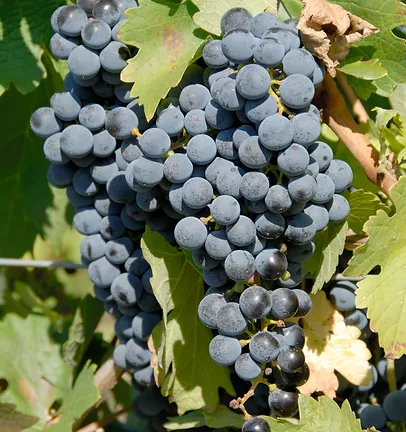
Is one of the world’s most widely recognized red wine grape varieties. It is grown in nearly every major wine producing country among a diverse spectrum of climates from Australia and British Columbia, Canada to Lebanon’s Beqaa Valley. Cabernet Sauvignon became internationally recognized through its prominence in Bordeaux wines where it is often blended with Merlot and Cabernet Franc. Despite its prominence in the industry, the grape is a relatively new variety, the product of a chance crossing between Cabernet Franc and Sauvignon blanc during the 17th century in southwestern France. The classic profile of Cabernet Sauvignon tends to be full-bodied wines with high tannins and noticeable acidity that contributes to the wine’s aging potential. In cooler climates, Cabernet Sauvignon tends to produce wines with blackcurrant notes that can be accompanied by green bell pepper notes, mint and cedar which will all become more pronounced as the wine ages. In more moderate climates the black currant notes are often seen with black cherry and black olive notes while in very hot climates the currant flavors can veer towards the over-ripe and “jammy” side.

